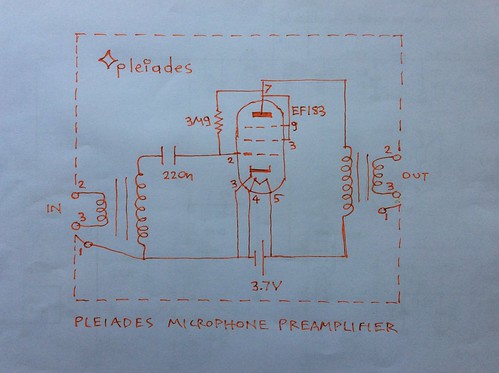A recent dream brought this to attention.
Instead of getting low Z out, on a microphone booster front end, from an output transformer such as the Pleiades V6 schematic:

Could a cathode follower configuration be used?
So just a resistor from cathode to ground. Signal out from cathode.
Anode connected to say 6V. An electron tube designed for low plate voltage operation or in fact almost any electron tube shouod be able to be used with the following procedure.
Operation at just 6V can be achieved by the following method.
The cathode is always more positive than the grid as it is missing electrons by emmision to the electron cloud.
If a high Megohm resistor is connected from grid to cathode we have pull up bias, therefore ncrease in anode current.
Alternatively a higher Mehohm resitor may be connected from control grid to anode or Vb for more pull up bias.
In all of these cases the grid potential can still be negative but less negative. (The grid potential or bias is by definition referenced to cathode). Input inoedance is not very very high but it is usually great for the secondary of a mic step up transformer.
Would this be a nice circuit to drive the input transistor of an Uher report reel to reel portable recorder?
Why doing this?
Input is studio quality balanced. Noise figure, S/N can be world class. Sound can be possibly the best sound. A world class dynamic microphone such as Sennheiser MD series, Electro-Voice RE series, Beyer Dynamic, Shure etc can be connected. Such mics suitably connected and front end amplified may send to the cleaners almost anything else.
How about the anode follower?
Of course it sounds great. For example resistance capacitance (RC) coupling, eg the Pleiades V4 mic prepreamp feeding the mic in of the Realistic Disco mixer. Or output transformer coupling eg Pleiades V6 front end mic amp seen on the above schematic, feeding the balanced mic in of Sony TC-D5 pro. Or Pleiades V1, one electrometer tube operating by 1.2V. See previous posts.
No comments:
Post a Comment